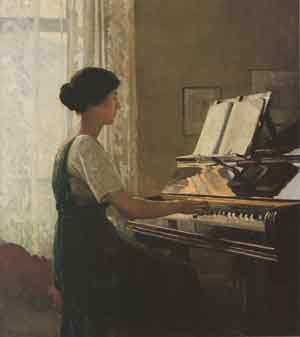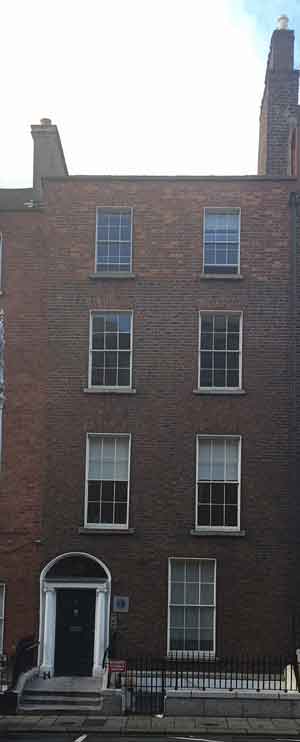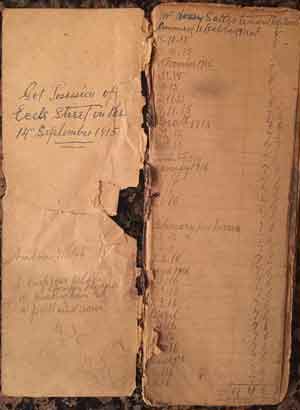73 ECCLES STREET—RECREATING A DUBLIN TENEMENT 1915–20
Published in Features, Issue 2 (March/April 2023), Volume 31By Ken Boyle
A worn old rent book, rescued from a skip, was to provide the opportunity and inspiration for this investigation. The compact book contained the names of the 37 tenants who occupied the nine separate units in 73 Eccles Street from 1915 to 1920, with details of their weekly payments. A coach-house and stables to the rear were also available to rent. The first page of the book contained the note: ‘Got possession of Eccles Street on the 14th September 1915’. The following five years were to be of huge significance in the city’s history.
THE PROPERTY
Eccles Street is situated in Dublin’s north inner city. No. 7 Eccles Street, now demolished, is known worldwide as the home of James Joyce’s fictional character Leopold Bloom and his wife Molly. No. 73 Eccles Street is a two-bay, four-floors-over-basement terraced property, built c. 1794. It is first listed as a tenement in the 1916 Thom’s Directory; 77 Eccles Street is the only other nearby property also listed as a tenement in that year. Various accounts of Dublin’s tenement history tell us that in 1900 there were over 6,000 tenements in Dublin, housing one third of the city’s population. This situation is often traced back to the abandonment of Georgian Dublin by many of the wealthy Anglo-Irish gentry following the Act of Union in 1800 and the dissolution of the Irish parliament. They left behind a surplus of unwanted elegant inner-city properties, leading to a slump in their value and their slow structural decline. By the mid-1800s these large, once-fine homes were providing an attractive financial opportunity to a growing body of landlords catering for an increasing population, added to by the drift of rural dwellers to the cities.
By 1900 Dublin had acquired notoriety for having the highest infant mortality and overall death rate, and incidence of tuberculosis, of any city in the United Kingdom. Behind these dreadful statistics lay a profusion of human misery, afflicting mainly the lower classes who occupied the city’s tenements. As a result of malnutrition, poor clothing, and primitive sanitary and heating facilities, many succumbed to the sickness and disease that thrived in the damp, overcrowded tenements. With estimates of one third of Dublin’s population living in them, however, tenements were the rental sector of their day. They were an important provider of shelter and homes, on which the poor and working class greatly depended. The chroniclers of the system are undoubtedly accurate in the broad picture of misery they describe, with many families living in dreadful conditions, often inhabiting single rooms. Nevertheless, given the ubiquitous nature of tenements at the time, they must have included properties of differing quality. Not all of them would have been slums; similarly, not all landlords would have been of the rapacious or rack-renting variety. It is likely that there were many decent property-owners among them, providing differing classes of tenement accommodation within the financial budget and expectations of their tenants.
In the case of 73 Eccles Street we can establish that it was a single-family residence up to at least 1911. In 1901 it was the home of the Middleton family, consisting of Jane Middleton, an 84-year-old widow, her 57-year-old son, Shireff, unmarried and employed as a principal clerk with the Inland Revenue, and his 50-year-old sister Frances. In addition, Mary Williams, their 21-year-old servant, lived in. The house is described as having ten rooms and being of first-class condition in the 1911 census, when it was still occupied by the Middleton family, although by this stage Jane Middleton had died and Shireff had retired. Frances died in November 1913. Interestingly, the 1894 Thom’s Directory had Shireff Middleton living at nearby 11 Dominick Street Lower, which it also gave as the address for Middleton’s Hotel.

Above: Leo Whelan’s Reverie (1920). His depiction of his sister Lily playing the piano in the drawing room of No. 65 Eccles Street provides a glimpse of what the interiors of these houses might have looked like at that time. (The artist’s family)
The Middletons were obviously a family of substance, with administrative and commercial experience, capable of maintaining 73 Eccles Street in good condition. The Whelan family, neighbours of the Middletons, ran a small hotel from 65 Eccles Street. Leo Whelan, their son, would go on to become a highly regarded artist, and his 1920 depiction of his sister Lily playing the piano in the drawing room of No. 65 (p. 43) provides a glimpse of what the interiors of these houses might have looked like at that time. The Middleton family connection with No. 73 appears to have ended by 1912, when it was listed as vacant. The following year, 1913, it was in the hands of Perrody Bros, general building contractors, who may have been instrumental in the subdivision of the property into the nine units that appear in the rent book. Each unit was descriptively named, e.g. Top Flat, Front or Back Parlour, Return Room, Back Drawing Room, etc.
THE TENANTS

Above: No. 73 Eccles Street today, across the street from the Mater Private Hospital, currently occupied by the hospital’s assistant CEO and its Cardiovascular Research Institute.
The rent book indicates that on 11 October 1915 the first tenant, Henry Salter, had commenced renting the ‘Top Flat’ at eight shillings a week. The 1911 census lists only one person by that name: a married man, originally from London, the father of three young children and a piano-tuner by trade. Another distinctive name which allowed for further investigation was William Fyfe, who rented the ‘Two Pair Back Room’ for just three weeks, curiously covering the period immediately before and after the 1916 Rising. The 4 June 1910 issue of the Longford Leader carried a report on a repossession application by William Fyfe of Edgeworthstown, a landlord. The judge dismissed the action after he found in favour of the tenants. Later we will see that 73 Eccles Street had a more direct connection with Edgeworthstown.
Four of the nine units in No. 73 had a change in tenants in the weeks following the Easter Rising. This unusually high turnover was possibly connected to the terrifying impact of the fighting on the inner-city area and its residents, with some possibly opting to move to other areas perceived as less dangerous. Sarah Hammond was one inner-city resident caught up on the fringes of rebellion. She was living in Hardwicke Street at the time, which is close to Eccles Street, and she was one of 60 individuals charged with looting before a special court ten days after the ending of the Rising. She was described as the widow of a British soldier and was sentenced to fourteen days in prison for being found in possession of three blouses at Upper Sackville Street (now O’Connell Street). The General Register of Prisoners records Mary Fennell, her mother, as her next of kin. The rent book for 73 Eccles Street shows Mary Fennell occupying the ‘Top Back Room’ from November 1918 to June 1919, and Sarah Hammond occupying the ‘Two Pair Front Room’ from February to June 1919.
Richard Colgan was another tenant of No. 73 who fell foul of the law. The 1911 census records just one person in Dublin by this name, a 22-year-old married man, a bookbinder by trade, living with his wife and one child in nearby Blessington Street. The 73 Eccles Street rent book has him listed as a tenant of the ‘Return Room’ from June to August 1916. The Evening Herald of 26 October 1922 reported on the case of Richard Colgan who had pleaded guilty to embezzlement from the staff tontine society of Armstrong and Co. Ltd, wholesale stationers of Amiens Street. He was sentenced to six months’ imprisonment.
THE LANDLORD
The Registry of Deeds shows that the purchaser of 73 Eccles Street in 1915 was Patrick Killean of 23 Synnott Place. He had owned a shop and public house in Edgeworthstown, Co. Longford. A widower, he died just five years later, aged 78, in September 1920. The final entries in the rent book are for July 1920. His Dublin properties passed to his son James. If Patrick Killean was somewhat elderly to be a landlord, his son James was a most unusual candidate for the position. James, who was born in 1874 and more often used the surname Killane, was heavily involved in both the political and military wings of the republican movement in Longford. He was arrested periodically and spent nine months in jail from March 1921. His periods of imprisonment must have made it difficult to manage the Dublin lettings.
James Killane does not appear to have left a personal record of his republican activities, but his wife Catherine left an account of her deep involvement with Cumann na mBan in her War of Independence pension application. In it she outlines how in 1920 her husband arranged for a consignment of rifles that he had obtained in Dublin to be delivered by train to Edgeworthstown, hidden among other goods. It would seem that James Killane was using his legitimate business presence in Dublin to the benefit of the IRA in Longford.
In conclusion, the short gap between the Middleton family’s ownership of the property and its conversion into nine units would suggest that No. 73 was in good order at the outset of its tenement status. The presence of the builders Perrody Bros subsequent to the Middletons’ departure might indicate that the conversion was professionally undertaken, thereby providing accommodation of a reasonable class. The rent book indicates that there were minimal increases in the rents applied over the five-year period covered, and in fact there were some reductions. The lowest rent recorded was just under three shillings a week for the ‘Return Room’, and the highest nine shillings for the ‘Top Flat’. For comparison purposes, Richard Colgan was stated to have been earning £4-10s. a week prior to his October 1922 trial. The rent book states that the income from the nine units and stable for 1918 and 1919 was marginally over £50 annually. As the property was held on a 999-year lease subject to a yearly rent of £12, the net income, inclusive of all expenses, was not significant.
James Killane died in 1930 and the property was still in the family’s ownership in the mid-1980s, some 70 years after its initial purchase and long after the era of the Dublin tenement had passed. Today the entrance to the Mater Private Hospital is situated directly across the street from 73 Eccles Street, which is currently occupied by the hospital’s assistant CEO and its Cardiovascular Research Institute.
Ken Boyle is co-author (with Tim Desmond) of The murder of Dr Muldoon: a Civil War story (Mercier Press, 2019).
Further reading
K.C. Kearns, Dublin tenement life, an oral history (Dublin, 1994).
C.J. Killean, Pension Application file, MSP 34REF 44897.
S. Ó Súilleabháin, Longford’s republican story 1900–2000 (Longford, 2021).

















